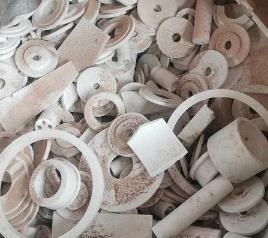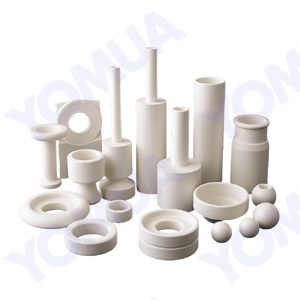The recycling and reuse of alumina ceramics is an important environmental and economic issue, especially in industrial applications where large amounts of waste alumina ceramics are generated. Below are several common recycling and reuse methods:

1. Physical Recycling Methods
- Crushing and Screening: Waste alumina ceramics are crushed into small particles and screened to obtain powders of different particle sizes. These powders can be reused as raw materials for ceramic production.
- Grinding: Waste ceramics are ground into fine powder, which can be used to manufacture low-performance ceramic products or as fillers.
2. Chemical Recycling Methods
- Acid/Alkali Dissolution: Strong acids (e.g., hydrochloric acid, sulfuric acid) or strong alkalis (e.g., sodium hydroxide) are used to dissolve waste alumina ceramics, extracting the alumina component, which is then reprocessed into high-purity alumina through chemical methods.
- High-Temperature Melting: Waste ceramics are melted at high temperatures to separate the alumina component, which is then reshaped.
3. Thermal Treatment Methods
- Sintering Regeneration: Waste alumina ceramic powder is resintered to produce new ceramic products. This method is suitable for applications with lower performance requirements.
- Thermal Decomposition: High-temperature treatment is used to decompose impurities in the ceramics, yielding high-purity alumina raw materials.
4. Use as Additives or Fillers
- Ceramic Raw Material Additives: Waste alumina ceramic powder is used as an additive in the production of other types of ceramic materials (e.g., refractory materials, abrasives).
- Composite Material Fillers: Alumina ceramic powder is used as a filler to enhance the performance of polymer-based or metal-based composite materials.
5. Direct Reuse
- Repair and Reprocessing: For alumina ceramic components that are not completely damaged, they can be reused after repair (e.g., surface coating, welding) or reprocessing (e.g., cutting, polishing).
- Downgraded Use: High-performance alumina ceramic components are downgraded for use in applications with lower performance requirements.
6. Environmental Treatment
- Harmless Disposal: For waste alumina ceramics that cannot be recycled, environmentally friendly methods (e.g., landfilling) are used to ensure no environmental pollution.
7. Innovative Recycling Technologies
- Biological Recycling: Microorganisms or enzymes are used to decompose organic impurities in waste ceramics, extracting the alumina component.
- Electrochemical Recycling: High-purity alumina is extracted from waste ceramics through electrochemical methods.

Application Scenarios
- Industrial Field: Recycled alumina ceramics can be used to manufacture refractory materials, abrasives, catalyst carriers, etc.
- Construction Field: Used as fillers or additives in building materials.
- Environmental Field: Used as filter materials in wastewater treatment or air purification.
Summary Table:
Recycling and Reuse Methods of Alumina Ceramics
| Method | Description | Applications |
|---|---|---|
| Physical Recycling | Crushing, screening, and grinding waste ceramics into reusable powders. | Raw materials for ceramics, fillers for low-performance products. |
| Chemical Recycling | Dissolving waste ceramics in acids/alkalis or melting to extract alumina. | High-purity alumina production, raw material regeneration. |
| Thermal Treatment | Sintering or thermally decomposing waste ceramics to regenerate materials. | Low-performance ceramics, high-purity alumina extraction. |
| Additives/Fillers | Using waste ceramic powder as additives or fillers in other materials. | Refractory materials, abrasives, polymer/metal composites. |
| Direct Reuse | Repairing or reprocessing undamaged components for reuse. | Reuse in original or downgraded applications. |
| Environmental Disposal | Safe disposal of non-recyclable waste ceramics to prevent pollution. | Landfilling or other eco-friendly disposal methods. |
| Innovative Technologies | Biological or electrochemical methods to extract alumina from waste ceramics. | High-purity alumina extraction, eco-friendly recycling. |
By employing the above methods, the recycling and reuse of alumina ceramics can be effectively achieved, reducing resource waste and environmental pollution. The specific method chosen depends on the nature of the waste ceramics, recycling costs, and the target application scenarios.